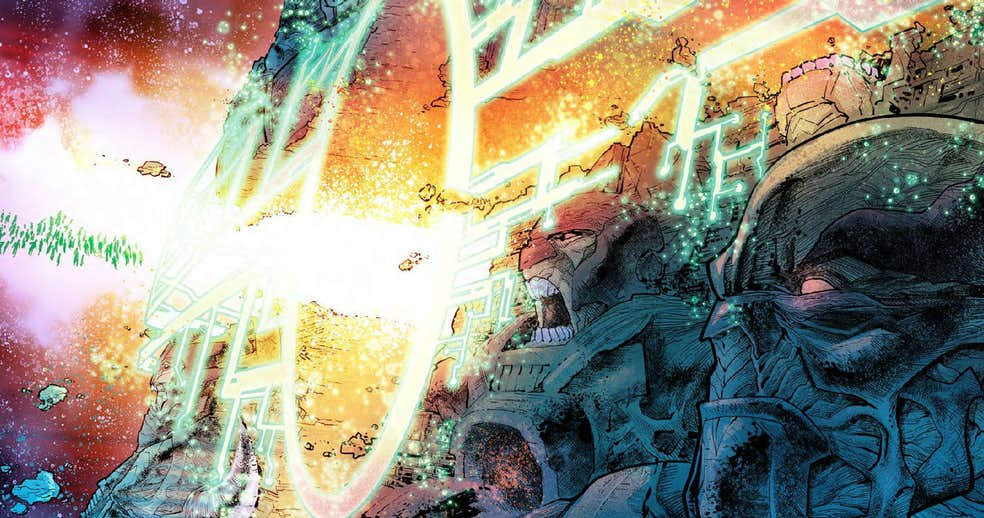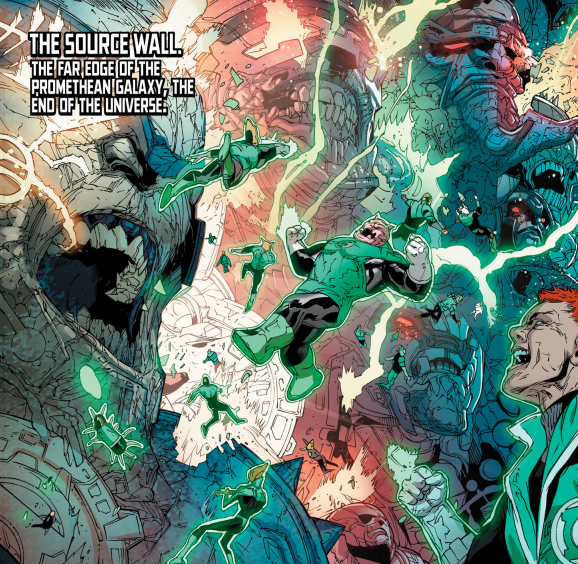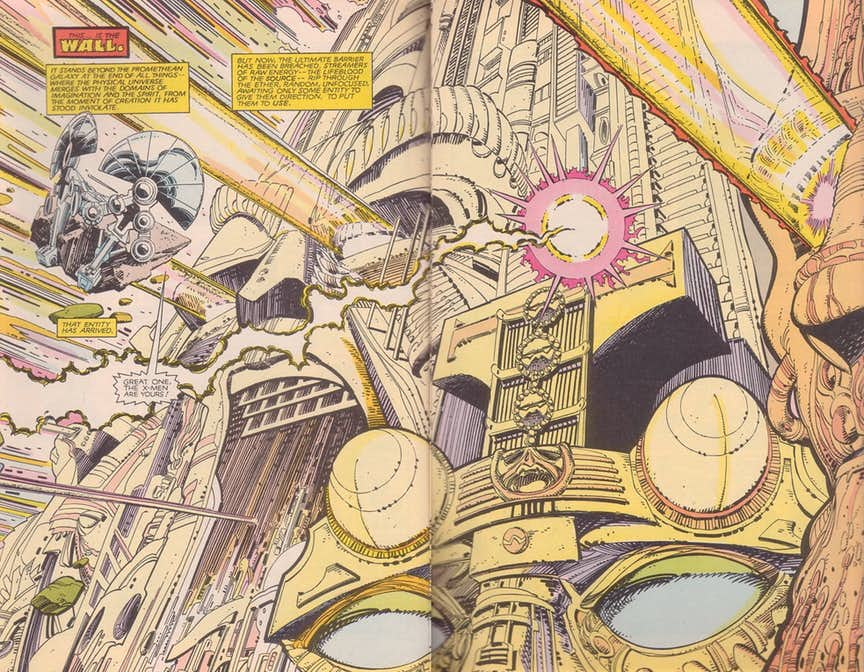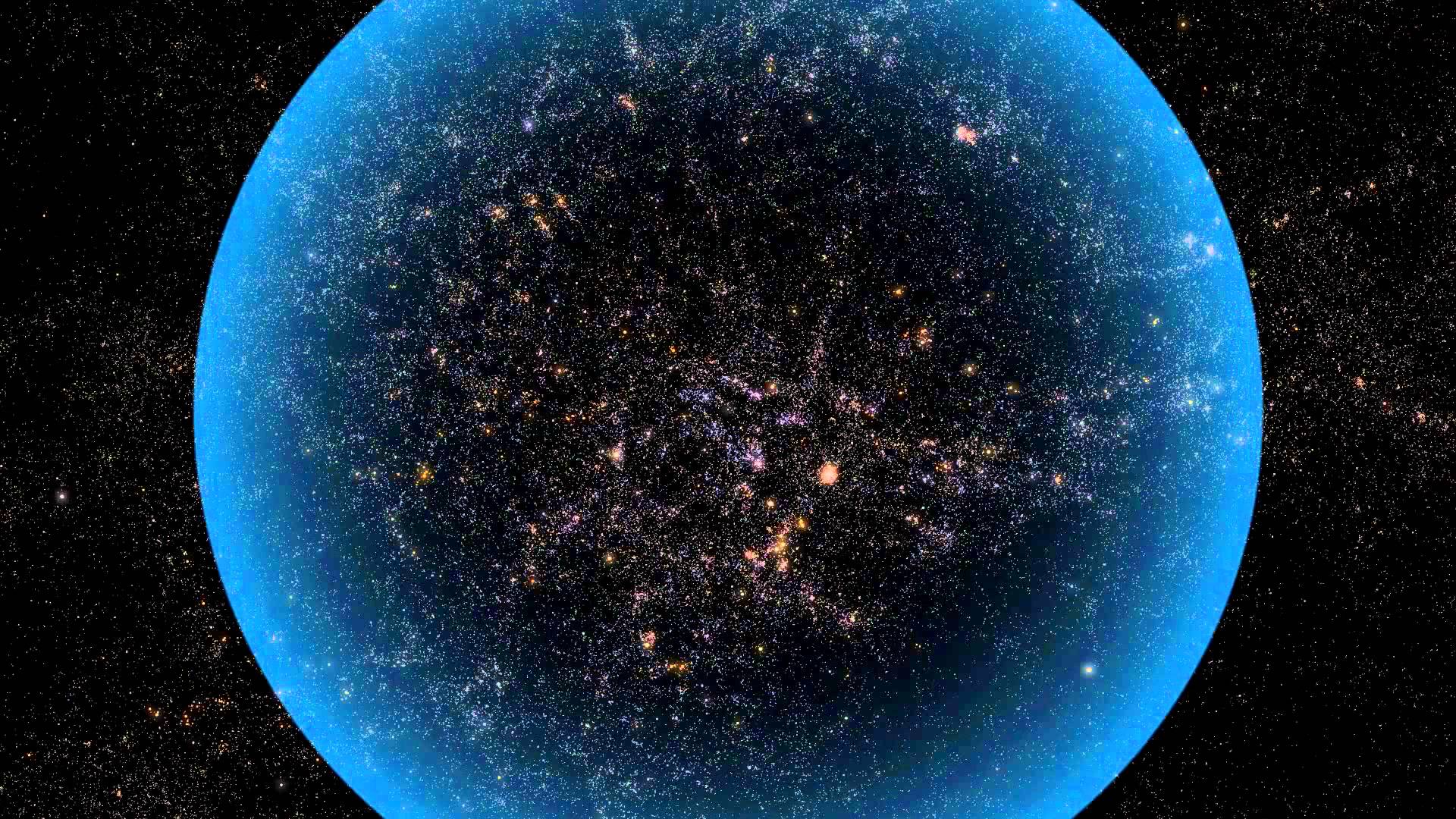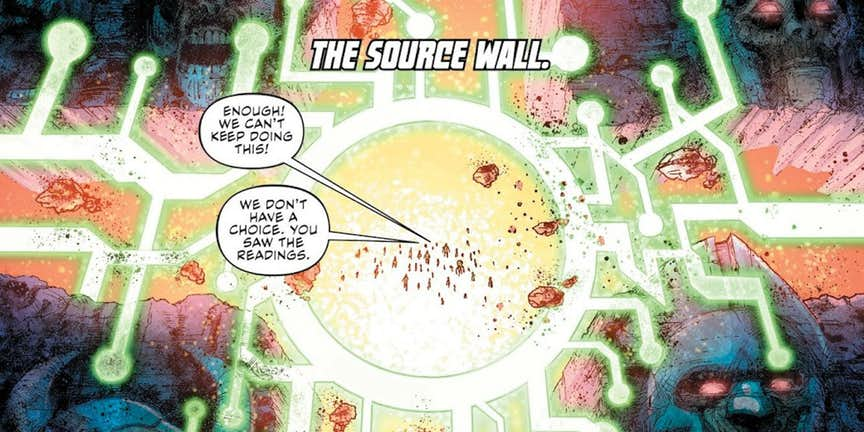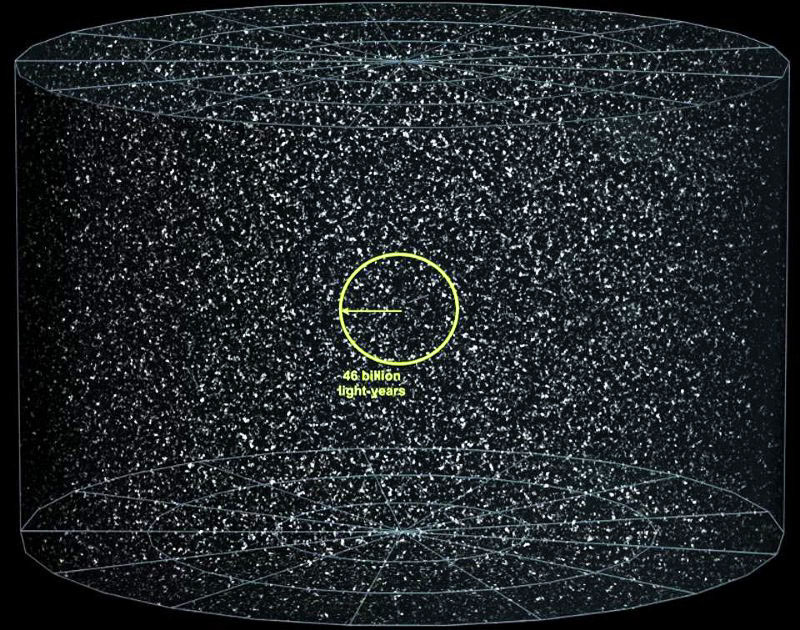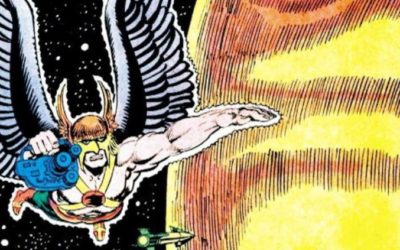DC Comics’ Source Wall has had a rough go lately. Because of the use of the “tenth metal” in Dark Knights: Metal #6, the Wall was broken open.
But what’s beyond it? And is there something like it in our world?
For decades, the specific of what lay behind the Source Wall had been hazy with reports from those who made the trip behind the wall contradicting one another or changing over time or, honestly, editorial whim.
Before we talk about what happened to the Source Wall, let’s talk about its origin a little.
Source Origin
As Brian Cronin explained at CBR, the Source itself was a feature of Jack Kirby’s New Gods series and was, in many ways, a stand-in for a universal creator. First mentioned by Kirby in New Gods #5, a “final barrier” lay between the Source and the remainder of the universe. Upon this barrier lay the bodies of the giants who sought to find the Source.
Though Kirby brought it into canon in 1971, it wasn’t shown until The Uncanny X-Men/New Teen Titans crossover in 1982. As artist Walt Simonson described, he and writer Chris Claremont took Kirby’s clues and descriptions and turned them into a massive wall made of massive stone bodies, a look that’s stuck ever since, and even crossed over into the animated Justice League series.
The look of the Source Wall is mythical and epic which is probably just the way Kirby wanted it. An apocryphal story suggests that he based his inspiration for the Wall from the African-American spiritual, “Rock My Soul (in the Bosom of Abraham),” which described comfort that was so great, the lyrics described it as being:
So high, you can’t get over it,
So low, you can’t get under it,
So wide, you can’t get around it,
You gotta go through the door.
Starting with the original intent of Kirby as being the barrier between the Source and the remainder of the universe, the purpose of the Source Wall itself has changed over the years. Through most of its existence, breaching it has been one of the main goals of the New God, Darkseid. His greed for the knowledge and power on the other wise of the Wall have led to him being imprisoned on the Wall on more than one occasion.
By the end of the event series, Countdown, it was established that each of the 52 different multiverses of the greater DC Universe had its own Source Wall, separated by the Bleed. The destruction of which would destabilize the particular universe, resulting in its destruction. The terminology surrounding the Source Wall can shift depending upon its use as well. Its location has been referred to as “at the end of the universe,” to “surrounding the multiverse.”
As mentioned above, the Source Wall has had some problems as of late – specifically a giant hole that has opened it up and allowed whatever is on the other side to come through. With a nod to the original mention back in New Gods #5, the Source Wall is again firmly located at “the far edge of the Promethean galaxy at the end of the universe. The stuff coming through – that’s a major problem – one that has been identified as something that could destroy the DC Multiverse.
The “Promethean” galaxy has always been a nice touch, as it was the Titan Prometheus of Greek myth who defied the gods by bringing fire to mortals, allowing civilization and progress. Prometheus’ punishment for his transgression was, of course, to be bound to a rock (or wall), where an eagle sent from Zeus was sent to feed on his liver…daily. Being a Titan, Prometheus’ liver grows back every night, just in time for the eagle to return the next day. Appropriately, the Promethean Galaxy was the home to the Promethean Giants who sought to know what was past the Source Wall, and as a result, were embedded in it.
The larger story concerning the Source Wall and its pieces has been spread over the new Justice League series, starting with the Justice League: No Justice miniseries where it was revealed that the entirety of the Green Lantern Corps is at the breach in the Wall, trying to repair it. In the recent Justice League #5, the Lanterns were joined by their opposite numbers, the Sinestro Corps – that’s how bad the problem is.
The problems of a broken Source Wall are starting to manifest in DC’s Justice League and Titans series, with other issues sure to come up.
So, the Source Wall – kind of ancient and cool, and now a big player in DC’s current and future plans.
Hm… a “wall” that separates the universe from everything beyond.
With the creation of the Source Wall, Kirby was doing what Kirby did best – blending myth, allegory and cosmology. Kirby was no slouch when it came to space and the cosmology of the day, so it’s not that much of a stretch to imagine that part of Kirby’s inspiration came from relatively recent confirmation of the Big Bang and the idea that our universe had an “edge” and perhaps there was something beyond that of which we would never know.
As far as we can tell, there’s no Source Wall in the real world. But that doesn’t mean there’s not an edge…of sorts.
How Far can You See?
I like to make comparisons between DC’s Source Wall and our universe, which has limit…kinda.
The observable universe is just that – how much of the universe we can see. As for how big the observable universe is…that’s not as easy a question as it sounds.
Let’s say you remember that the universe kicked off with the Big Bang, about 13.8 billion years ago. Let’s also say that you remember that light moves 3.0 x 108 m/s a year, which means that light travels (convert a year into seconds and multiply it by 3.0 x 108) 9.5 billion kilometers/year, about 9.5 trillion miles. This is simple, right? Multiply the time by the speed and you’ve got the distance, or how far we should be able to see out, with our most powerful telescopes.
Do that multiplication, and you get 1.3 x 1020 km, which is about 13.8 billion light years. That answer makes sense – light has been moving since the start of the universe, and the universe is 13.8 billion years old, so we can see 13.8 billion light years in any given direction. In geometry-talk, that means that the observable universe is a sphere with the earth at the center and a radius of 13.8 billion light years. Cool – it makes sense.
But it’s not quite correct.
Since just after the Big Bang, the universe has been expanding. Everything has been spreading out, getting farther away from everything else. Again, let’s say you’re looking at something that’s 13.8 billion light years away (there are a few reasons why that number isn’t quite correct, but we’ll let them go for the sake of our example). That light took 13.8 billion years to get to the earth. During those 13.8 billion years, the universe has been expanding. That star that you’re looking at – it’s no longer 13.8 billion light years from earth. It’s farther away. Given observations of the expansion that have been made over decades, that star is now 46 billion light years away.
If you do the calculation, you’ll realize that means that the star was moving faster than the speed of light. Yup. No, seriously – it’s okay. Einstein says that nothing can move faster than light, but he says nothing about space itself moving faster during its expansion. Additionally, that star’s not the only thing moving in this equation. Everything is moving away from everything else. It’s like trying to figure out how fast your friend’s car is going if the two of you are backing away from each other at 30 miles an hour.
So, that star that you see – the 13.8 billion year old one(*)? It’s 46 billion light years away, and that marks the edge of our observable universe. Our “universe” is a sphere with a radius of 46 billion light years. The most distant objects that we can see are at that 46 billion light year limit, but we’re seeing the light they released when they were much closer to us, 13.8 billion years ago. That distance, a radius of 13.8 billion light years makes up a sphere called the Hubble volume. Things beyond that volume are receding from the observer (us) at a rate greater than the speed of light.
In other words, the size of the observable universe > the age of the universe. The light from the thing is 13.8 billion light years out, but the “thing” is 46 billion light years away. Our observable universe consists of the earth at the center of a sphere that has a diameter of 92 billion light years (**).
If you’re looking for a place to call the universe’s “edge” that has my vote.
Well, kinda. Going back to the idea of the observable universe as a sphere, that means the earth is at the center. Repeat after me: the earth is not the center of the universe. It’s the center of our observable universe because we’re doing the observing. Move to Saturn, and redraw the observable universe map, but this time, Saturn’s at the center. Honestly with the distance scale we’re talking about here, swapping earth for Saturn would make zero difference.
How Do I Get to the Edge of the Universe?
If we make the analogy between DC’s Source Wall and the edge of the observable universe…well, the Source Wall has a lot of visitors. It seems that the Green Lantern Corps has had a significant chunk of its membership there since the end of Darkest Night: Metal, and it’s been a pretty regular spot for storytelling involving the New Gods since its first appearance.
Getting there, though – getting to a location 46 billion light years away, and being home for dinner? You’d have to use some fantastic means of conveyance. While that’s always been the assumption (at least my assumption) when DC characters pop on over to the Wall for a visit or a battle, it was finally Lex Luthor who put some DC super-science to it. In Justice League #5, Luthor pops over for a visit (see how casual travel to the Source Wall has become?) to chat with Sinestro. As for how he got there, the exchange between the two reveals it all:
Sinestro: LUTHOR?! How can you be here –?
Luthor: A scientist who used to work for me called it Quantum Folding.
A wrinkling of space-time that would allow you to move from one side of the universe to the other with a single step.
He said it would take thousands of years to become technologically viable, so I fired him and systematically decimated his life.
It turns out he was right, but all that misses the point entirely.
Okay, “quantum folding” is a concept in mathematics, mostly, and what Luthor is talking about here sounds a lot like A Wrinkle in Time’s tesseract, which does have some science-ish ideas behind it, but as I mentioned, I’ll let that go as super-science and give it a pass.
What if you wanted to get to the edge of the observable universe, 46 billion light years away? And yeah – use the 46 billion light years, not the 13.8 billion light years. Remember – nothing is there at the 13.8 billion light year distance. The star (***) that made that light is now 32.2 light years further out than that.
All of that aside, what about traveling there to see if our universe has a Source Wall with Promethean Giants embedded in it – how long would it take to get there?
Sorry to burst your bubble, but you can’t.
And I’m not talking about using current technology (our fastest ship ever, the just-launched Parker Solar Probe has a top speed of 430,000 mph, or about 7.31 x 10-8 light year/hour. At that rate, if everything stood still, it would take you 7.1 x 1013 years to reach the edge. That’s about 5300 times the age of the universe.
But before you go there – this isn’t a technology thing. “Oh, if only we had light speed travel…” Barring any now-fictional means of travel, you’d never reach the edge of the observable universe. Recall what I just said up there – if everything stood still. Thing is, nothing is standing still. The universe is expanding, and to screw up your travel plans even further, it’s speeding up. You might leave for the edge of the universe, but you’d never get there. It’s moving away from you faster than you’re moving towards it.
But What’s Over the Edge?
Let’s say you somehow catch up to the edge of the observable universe with respect to earth, and peer past it. What would you see past that final star?
More universe, most likely.
Following the larger ideas of inflation and the expanding universe, there’s no reason to think that the universe stops with us. It just goes on and on and on. But it’s separated into what physicist Brian Greene likes to call a “patchwork quilt” – distinct areas of observable universe (depending upon the observers), beyond which, the observers will never see or interact with.
In fact, if you imagine the universe as one big – strike that, one infinitely large quilt, then there’s no way we could ever contact anyone in the next patch over. Or five patches away. If the universe is infinite, that means there are an infinite number of patches. And if there are an infinite number of patches, in an infinite number of them is another version of you. And me. The patchwork quilt idea of the universe is just one of a number of ideas of a multiverse – a vast, infinite collection of universes, all separated by insurmountable distances.
In that sense, the Source Wall(****), as a barrier between distinct universes, might be pretty spot on.
(*) Okay, okay I can’t go on saying this without adding some more to it – no star is 13.8 billion years old, because stars didn’t show up until about 200 million years after the Big Bang at the earliest, which takes it down to 13.6 billion years. On top of that, though – the oldest stars (called Population III stars) aren’t even around anymore. They’ve all died. The oldest stars that we can see are called Population II stars and are around 13 billion years old. Now…whether those stars still physically exist…probably not. We’re only seeing the light they emitted 13 billion years ago.
(**) Yeah – the idea of the universe as a sphere doesn’t work that well with the idea of a Source Wall being in one particular location in the universe – at the end of the Promethean Galaxy. You want to tell the heroes, “There are ways around this wall, you know…” But I have more exciting thoughts on this. Just wait for footnote ****!
(***) I know, I know.
(****) Although, come on – if the observable universe is a sphere, how can it be bounded by a wall? A Source Belt? I like to think of the Source Wall as a Source Shell that extends both up and down and encircles the entire DC Universe in a ball. Our heroes (and villains) call it a wall because of scale. Put an ant on the inside of the Goodyear Blimp, and it would tell you it’s walking on a wall. It’s too small to see the curve. But “Source Shell” has zero zazz. But if the Wall is a Shell, then we can figure out the volume, based on the radius and figure out the surface area of the sphere with a radius of 46 billion light years, and make some approximations about how many Promethean Giants must be embedded in it. But then, the sphere of the observable universe is always expanding, so there will always be more room. In a sense, the Source Sphere would “hunger” for new inhabitants.


